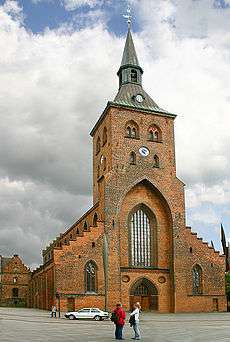Roman Catholic bishopric of Odense
| Diocese of Odense Dioecesis Othoniensis Odense Stift | |
|---|---|
|
St. Canute's Cathedral, seat of the bishop of Odense. | |
| Location | |
| Country | Denmark |
| Ecclesiastical province | Lund |
| Metropolitan | Archdiocese of Lund |
| Information | |
| Denomination | Roman Catholic |
| Sui iuris church | Latin Church |
| Rite | Roman Rite |
| Established | 988 |
| Dissolved | 1536 |
| Cathedral | St. Canute's Cathedral in Odense |
The former Roman Catholic bishopric of Odense was a bishopric on the Danish islands that included the islands of Funen (where Odense city, its episcopal see, is located), Langeland, Tåsinge, Lolland, Falster, Als and Ærø. The diocese was disputed as suffragan between the archdioceses of Hamburg-Bremen and Canterbury. Like the rest of present Denmark, in 1104 it became suffragan of the Metropolitan Archbishop of Lund (the primate of all Scandinavia), the only diocese of the province presently outside Denmark: in Scania, now the adjoining south of Sweden, then Danish territory.
Diocesan history
It was founded before 988 from Schleswig, and the first church built at Odense was dedicated to St. Mary. Othinkar Hvide the Elder, a missionary bishop in Sweden, is said to have preached Christianity on Funen, but the first Bishop of Odense whose name is known with certainty is Reginbert (Reginar), an Englishman consecrated by Archbishop Alnoth of Canterbury in 1020 or 1022 and sent by King Canute the Great to Denmark. Reginbert was succeeded by Eilbert, a clerk of Bremen (about 1043-72). After his death the diocese was vacant and subject to the Bishop of Roskilde, until 1086, at the earliest, when the English Benedictine monk Hubald was appointed its bishop. On 10 July 1086, King/Saint Canute was murdered in the Church of Sankt Albani (St. Alban's) in Odense. The fame of his miracles and the bad harvests which followed upon his murder led to his canonization and to the translation on 19 April 1101 of his relics by Bishop Hubald to the new Church of Our Lady and St. Alban. At King Eric Ejegod's request King William II of England induced the Abbot of Evesham, Worcestershire, to send over twelve of his monks to Odense in 1100 who served the newly erected Cathedral of St. Canute, and later they and their successors formed the chapter. The Church of St. Canute, which was at first of wood, and connected with the great Benedictine monastery of the same name, was burnt down more than once, and the present fine building was not begun until the time of Bishop Gisico (1287?-1300?). It is built of brick in pure Gothic style, and is considered one of the largest and finest ecclesiastical edifices in Denmark. Its construction was continued under his successor, bishop Peter Pagh (1304–39), who apparently assisted, even if he did not found, the school at Odense. The next bishop, Nicholas Jensen (1340–62), made the school a free one in 1349; before this the pupils paid half the cost of their education. Bishop Mogens Krasse (1460–74) seems to have finished the cathedral. His successor, Charles Rønnow (1474–1501), who had been provost of the Church of Our Lady, was hostile to the Benedictine monks at St. Canute's, and in 1474 drove them from the cathedral, replacing them with regular canons. It was not till 1489 that the monks were brought back, at the command of Innocent VIII.
Long before this Odense was one of the richest bishoprics in Denmark. It was so exclusively regarded as belonging to the nobility that the famous Bishop Jens Andersen Beldenak endured much persecution on account of his humble origin. In 1529 he resigned his bishopric to Canute Henriksen Gyldenstjerne, Dean of Viborg. The latter can scarcely be regarded as a Catholic bishop. His election was never confirmed by the pope, and though imprisoned in 1536 he was released in 1537. From the beginning of his episcopate he had practically been a Lutheran, and after 1537 he married and lived as a rich lay nobleman until his death (1568).
Besides the cathedral at Odense with its crypt, containing the bodies of St. Canute and of his brother Prince Benedict, and its glorious reredos etc., there are many fine churches at Nyborg, Svendborg and elsewhere. Before the Reformation the diocese had Augustinian Canons at St. Mary's, Odense; Benedictines at the cathedral, Odense and at Halsted (Lolland); Benedictine (?) nuns at St. Gertrude's, Odense; Augustinian nuns at Dalum; Cistercian monks at Holm (Insula Dei), now Brahetrolleborg; Franciscans at Odense, Svendborg, Nysted and Nykøbing Falster; Dominicans at Odense; Carmelites at Assens; a convent of Poor Clares at Odense; and a Brigittine abbey at Maribo (on Lolland), the latter until 1620. Finally there were hospitals of the Holy Spirit at Odense, Assens, Faaborg and Nakskov, and a Commandery of the Knights of St. John at Odense.
Aftermath
The former Catholic dioceses in Denmark were never reestablished. Instead, the new Catholic missionary clergy in the whole, predominantly Lutheran, country was made part of the 7 July 1868 established Apostolic Vicariate of Northern Missions, which in 1869 was demoted as Apostolic Prefecture of Denmark, on 15 March 1892 promoted as Apostolic Vicariate of Denmark.
Finally on April 29, 1953 it was promoted as exempt Diocese of Copenhagen, including the Danish overseas territories of Greenland and the Faroe Islands
Sources and references
-
 This article incorporates text from a publication now in the public domain: Herbermann, Charles, ed. (1913). "article name needed". Catholic Encyclopedia. New York: Robert Appleton. Catholic Encyclopedia
This article incorporates text from a publication now in the public domain: Herbermann, Charles, ed. (1913). "article name needed". Catholic Encyclopedia. New York: Robert Appleton. Catholic Encyclopedia - GigaCatholic- Denmark
